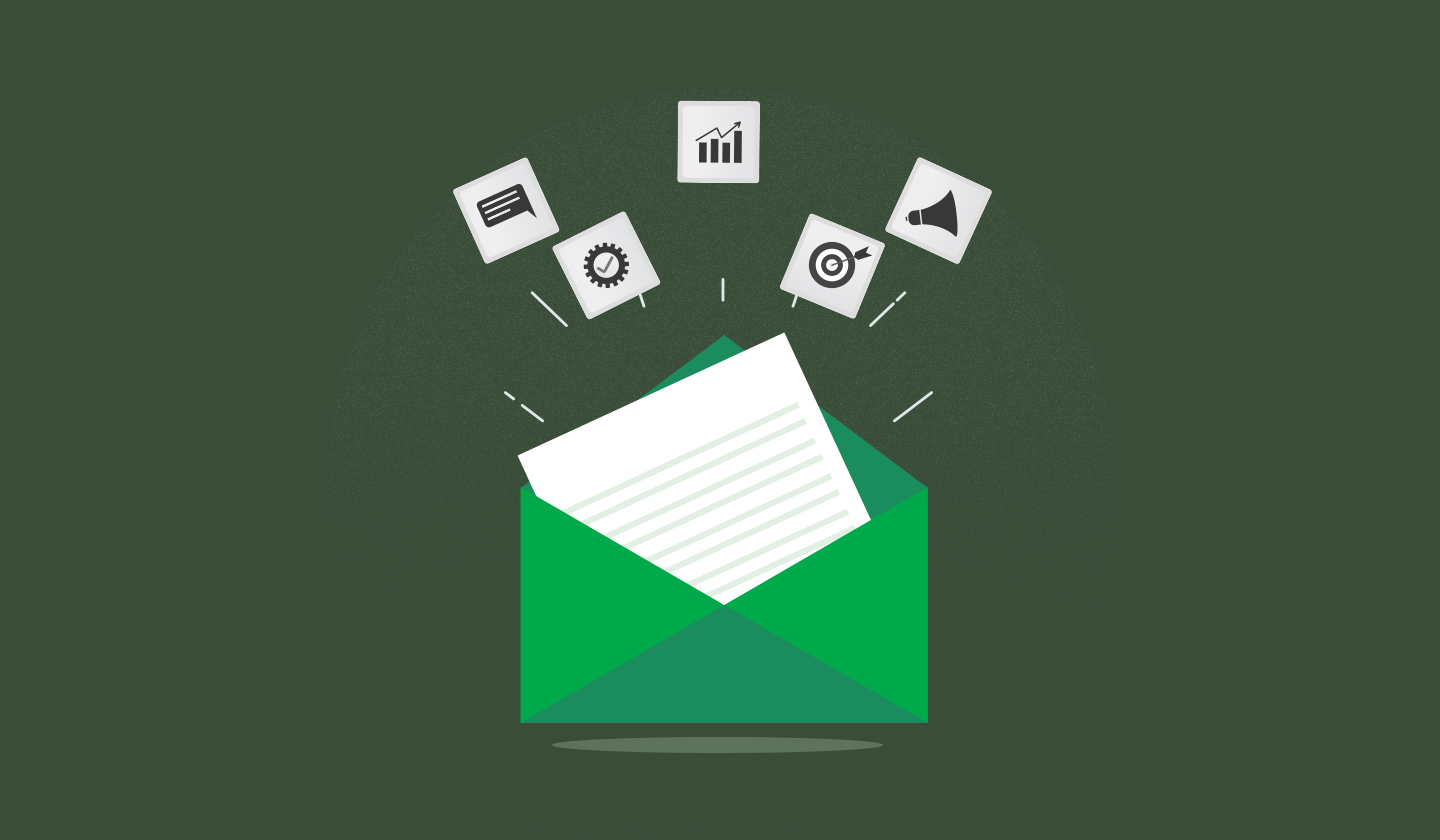Email continues to be the most high-performing marketing channel, with a remarkable ROI of $36 for every $1 spent. This is a good enough reason for marketers to be on their toes and gather more profound knowledge to improve their email campaigns.
This is why email insights will play a massive role in shaping strategies in the coming year. In this article, we discuss email insights that will be valuable for your campaigns in 2024.
What Are Email Insights?
Email marketing metrics and stats come together to help you derive knowledge to help you with future actions. This knowledge is referred to as insights.
Email insights help you make informed decisions and plan your email campaigns with a higher chance of success.
For example, a bounce rate of 10% tells you that you need to change your current approach. This is a high number of emails coming back to you. It could be a sign of an unverified email list and you may need a more thorough cleansing of your list.
Let’s talk about some metrics that are vital in compiling the most valuable insights. We will also take a quick peek at the prevalent industry standards for these metrics in some industries.
Some email metrics that help determine Insights
While some insights are generic, others are specific to your business needs. To determine these, you need to track the right email metrics. Here are some metrics that are important to help you find the right insights for your business. You’ll also see how these insights vary by industry and see the impact of each.

Conversion rate
Conversion rate is the most critical email metric. This is also the email metric that you want to measure before the others. If the conversion is not up to your standards, you would want to dig deeper into other metrics.
It helps you determine the percentage of successful emails. Whether your email goal is a sale or a signup, you can use conversion rate to conclude the success of your emails. Poor email conversion means your content or design does not meet your requirements, and you need to review other metrics to determine what’s going wrong.
Every industry has its own benchmark conversion metrics. And before you start worrying about the performance of your emails, it’s best to know what range of conversion rates is generally the standard for your industry.
For example,
The email conversion rate for the automotive industry is 3.9%,
The email conversion rate for the real estate is 3.5%,
The email conversion rate for the travel industry stands at 3.3%, and
The email conversion rate for the healthcare industry is 2.6%.
CTR
Email click-through rate is a vital stat that determines the rate of clicks on different links provided in the email. Contextually, this is the yardstick that helps you evaluate the engagement of your audience with the message you sent.
This helps you collect quality insight on link placement, hyperlinked text, and more. Other factors directly related to the CTR include content quality, formatting, and length.
The CTR by industry is quite interesting too.
The email CTR for the automotive industry is 7.7%,
The email CTR for the real estate is stands at 8.6%,
The email CTR for the travel industry is 6.8%, 6.7%, and
The email CTR for the healthcare industry stands at 6.8%.
Unsubscribe rate
The unsubscribe rate is where you determine the degree of disconnect your audience may feel with your brand message. It is the number of subscribers opting out of your email list.
You can compare your unsubscribe rate for the year against a recent campaign to determine whether your campaign is targeted at the right audience or needs tweaking.
When we look at industries,
The automotive industry has a 0.22% of unsubscribe rate,
The real estate has the best unsubscribe rate of 0.21%,
The travel industry has a 0.26% of unsubscribe rate, and
The healthcare industry has a 0.39% unsubscribe rate.
Email deliverability rate
Email deliverability rate helps determine the percentage of emails successfully delivered to your list. There are multiple reasons for emails failing to reach the intended inbox. It could be a huge attachment, a wrong or misspelled email address, or a poor domain reputation. This valuable metric gives you insight into the quality of your email list and determines if it can help you reach the intended results.
As a result, the email never reaches the inbox, or ends up in the spam folder of the receiver.
In terms of industry averages, the email not landing in the inbox have varying rates:
Email deliverability rate for real estate stand at 97.1%,
Email deliverability rate for the travel industry is 94.5%, and
Email deliverability rate for the healthcare industry is 89.8%.
List growth rate
The list growth rate determines the increase or decrease in the number of subscribers your list has seen over a selected period. Knowing the growth rate can help you evaluate the performance of your lead-generation content.
This is how these stats for the selected industries compare.
Industry | Conversion Rate | CTR | Unsubscribe Rate | Deliverability Rate |
|---|---|---|---|---|
Real Estate | 3.5% | 8.6% | 0.21% | 97.1% |
Automotive | 3.9% | 7.7% | 0.22% | - |
Healthcare | 2.6% | 6.7% | 0.39% | 89.8% |
Travel | 6.8% | 6.8% | 0.26% | 94.5% |
These are some of the significant email metrics among many that you want to measure to derive insights and make better decisions.
How Email Insights Help Different Business Areas?
What you can’t measure you can’t improve, right? Exclusive knowledge about any business aspect can be a powerful help. And this is the power that email insights bring you. Different business areas can benefit if you have the right email knowledge.

Reduces mistakes by knowing your audience
You have always been taught to learn from your mistakes. This is precisely the case here. You have the data, you now know your audience, and it will be a huge benefit if you plan your marketing accordingly. With the right email insights, you can avoid many mistakes that can halt the revenue generated.
Every previous campaign that did not perform well should be reviewed to see what could have caused the poor results and what could be done differently the next time.
Improves targeting
Insights will help you narrow down the ideal customer profile for your business and help you understand what your customer looks like. This is where you get the knowledge to target your marketing to improve your conversion rate and boost your email marketing success.
Helps personalize content strategy
Once you know the ICP, you know who you are writing for. Your content strategy will now turn into a conversation with the ideal customer that you have in mind, making your content strategy personalized and increasing the chances of success.
Tailored sales approach
Your business can have multiple ICPs, and email insights can help you determine those. With this knowledge, your sales team can tailor their sales pitch or message accordingly and choose winning messages for each customer profile.
Gets you more budget
Marketers often need to justify the requested spending or sometimes request a bigger budget than provided. A presentation backed by email data can help justify your requirements and secure a much higher budget for future marketing efforts.
Refines buyer personas
As you gather data, you keep learning more and more about the buyer persona you target. Data on the most engaged and highest-spending customers should be used to define the profile that is more likely to connect with you.
This will help sales teams to convert the more ideal prospects faster and categorize the leads accordingly.
Better tracking of trends to forecast demand
Email marketing is a very consistent channel. This is why it is easy for marketers to notice a shift in consumer behavior when interacting with emails. This change can help you determine trends and forecast the demand after a specific campaign. As a result, you can increase or decrease production and pace up the required processes.
Vital Email Insights You Didn’t Know You Need
Mailjet’s research from 2022, is the main source of stats and information used to derive the following insights. The information has been hand picked keeping today’s market needs in mind. This compiled list of email insights will help you through your email marketing plans in 2024.

1. If you are marketing for a small business, you will mostly feel that your email marketing is not up to the mark or lacks aspects. As a small business, you have only polished your email marketing for so long, whereas an enterprise would have had it running for years and thus refined it with time.
2. If you are a small business and constantly feel that your email marketing does not perform as well as it should, you’ve got nothing to worry about. This is because you have hundreds of things that you can still try with your strategy. At this level, you have only practiced your email marketing for a while compared to an enterprise doing it for decades. So, the number of years invested reflects on the time invested to learn from mistakes and refine the strategy.
3. The usage of email tools is on the rise. Excellent tools on the market that you can count on for building, designing, sending emails, and following up on performance statistics. Now, with the help of AI, tools continue to get more powerful. For example, Unlayer now makes the entire design process seamless with powerful AI to generate original images and text and then drag and drop your way to a classy end result.
4. Email accessibility is now becoming a highly essential aspect of email design. 57% of marketers consider color contrast, screen readers, and ADA compliance when designing emails. Using subheadings, making buttons easily noticeable, and adding links also significantly contribute to email accessibility. For emails to perform well and for viewers to be comfortable interacting with your emails, you must consider accessibility factors every step of the way when designing.
5. Everyone tells you that email marketing is the most successful marketing channel, but hardly anyone mentions the challenges and setbacks. Email marketing does not happen without hiccups. The top four challenges that most marketers face are:
Increasing engagement
Integrating email data with other data
Improving accessibility
Creating an overall strategy
6. A solid strategy and a measurement plan are vital for success. You cannot continue email marketing by making up emails on the go. With a defined strategy, you step out of planning and allow you to address challenges like improving accessibility and engagement.
7. Integrating email data with other data is often overlooked in terms of its importance. But you’d be surprised to know that 92% of most successful marketers consider data integration essential in improving email performance.
8. Personalization, security features, interactive content, and responsive design are the four most highly followed email marketing trends.
9. Top marketers highly value using dynamic content extensively, or at least sometimes, which shows it is a huge reason for success.
10. Images and body text are the two main hosts for dynamic content.
11. With open rate out of the question because of Apple’s privacy policy updates, conversion rate, and ROI are the two most common metrics for measuring success.
12. Micro-Segmentation is now the key to maximizing email engagement. You can divide your email list by behavior, sentiment, shopping patterns, location, seasonality, and more. This allows you to divide the list into smaller segments and maximize engagement by improving personalization.
13. AI automation tools are booming, and new tools are hitting the market faster than we can imagine. This can impact your email generation, improve efficiency, clean email lists, and more. You must stay aware of all AI tools to stay ahead of the email marketing curve.
14. Emphasis on customer relationships is on the rise. Thank you for placing your order; here’s your birthday discount, early access to a new product, a special discount for being a VIP customer, and more. Building a healthy customer relationship will remain the key to recurring customers and increased sales.
Final Words
Making your email campaigns more successful is a challenge marketers face very frequently. This is where email insights come in to help boost email performance. With these email insights you can start planning your campaigns for 2025 right away.





